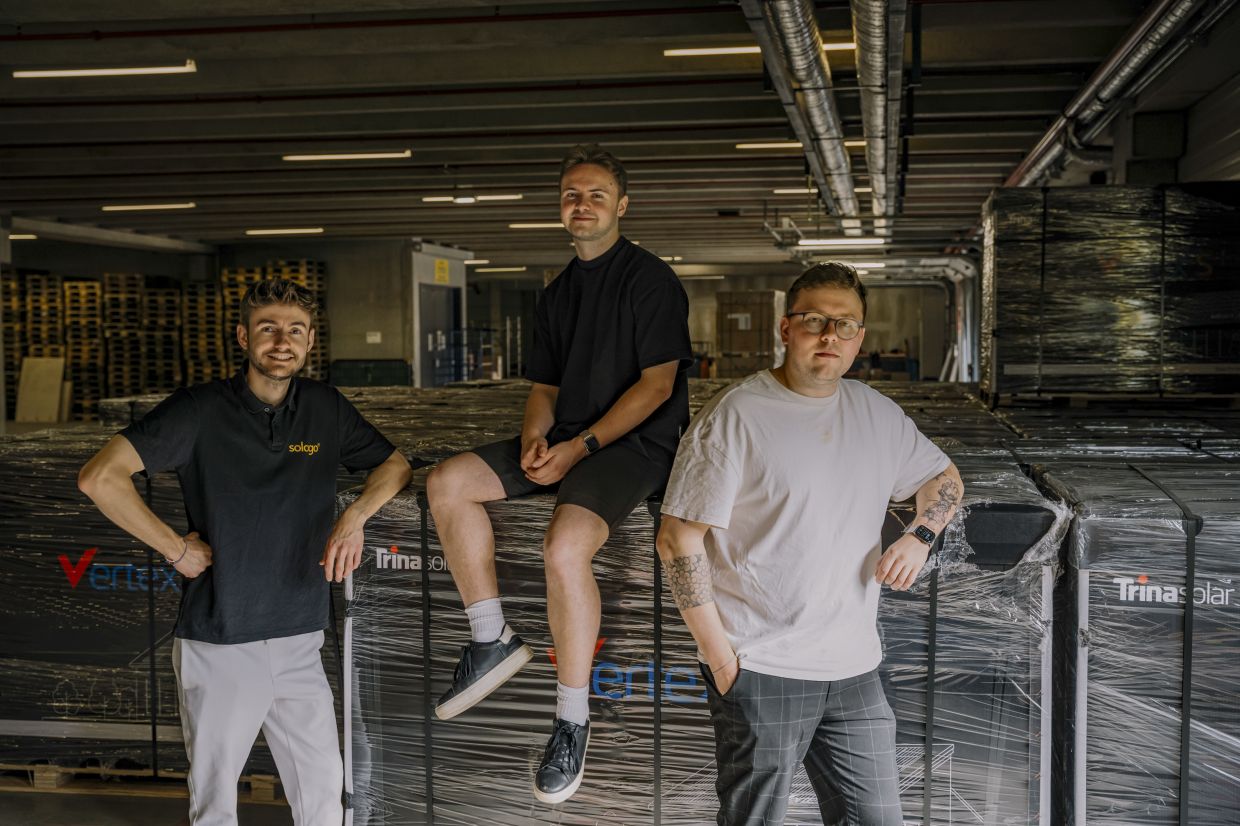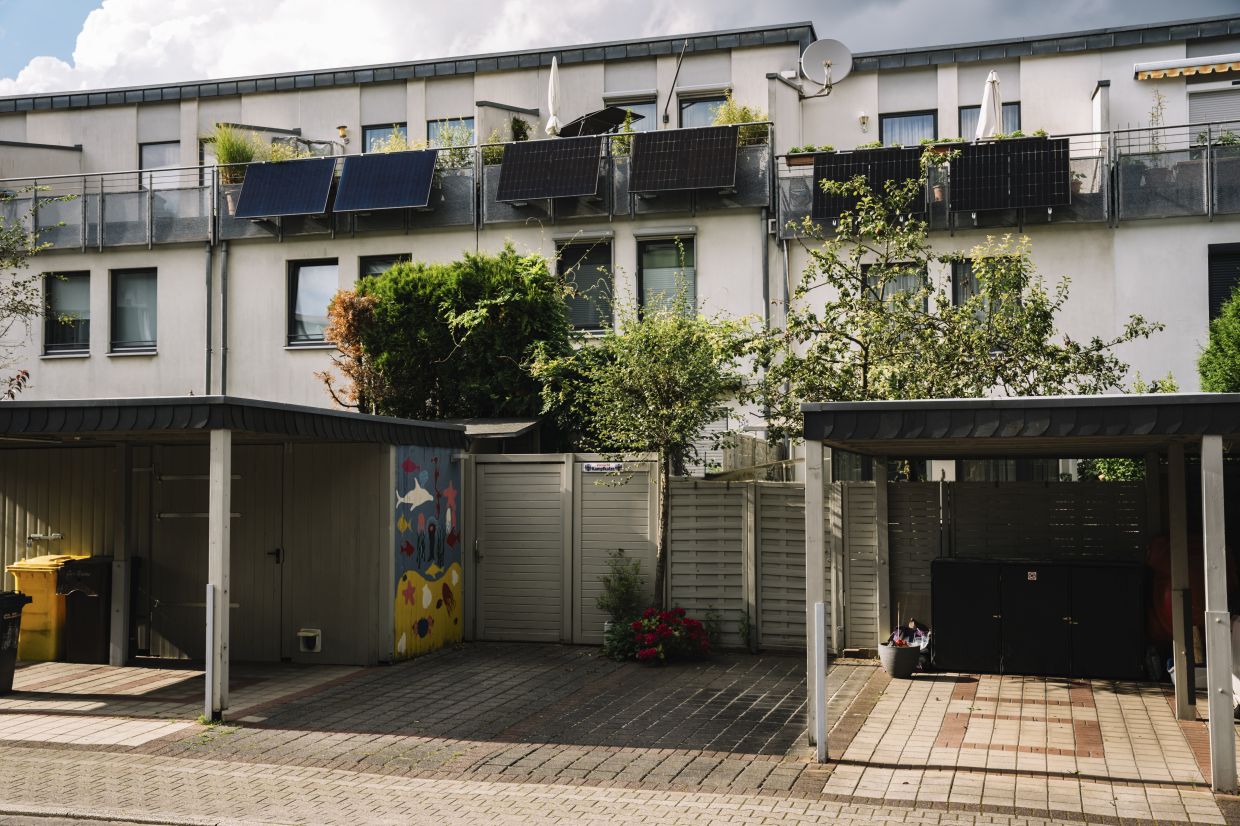Heiko Billen installs a solar panel at his house in Düsseldorf, Germany, on July 10, 2024. People across Germany are installing lightweight solar panels, without the need for an electrician or heavy tools. — The New York Times
BERLIN: At a Berlin trade fair for sustainability, a new gadget caught Waltraud Berg’s eye – a solar panel small enough to be easily installed on the side of a balcony and then plugged into a wall socket to feed energy produced by the sun directly into her home.
“I was absolutely thrilled to learn that such a thing even existed, that you can generate your own power and be more independent,” said Berg, a retiree who installed several panels on the south-facing balcony of her Berlin apartment by herself.
Each of the lightweight panels produces only enough electricity to charge a laptop or run a small refrigerator. But in homes across Germany, they are powering a quiet transformation, bringing the green revolution into the hands of people without requiring them to make a large investment, find an electrician or use heavy tools.
“You don’t need to drill or hammer anything,” Berg said. “You just hang them from the balcony like wet laundry in Italy.”
More than 500,000 of the systems have already been set up across Germany, and new laws that relaxed rules around solar panel installation have contributed to a boom in use. In the first six months of the year, the country added 9 gigawatts of photovoltaic capacity, the amount of solar power a system produces, according to the Federal Network Agency, a German regulator.
“We are seeing a continuous increase in solar installations in particular,” said Klaus Müller, president of the agency. “Compared to the total capacity at the end of 2023, almost 10% more solar capacity was added. Of that, two-thirds was installed on buildings, which includes balcony systems.”
As part of its push to move away from dependence on Russian natural gas, the European Union is looking to quadruple the amount of power generated through photovoltaic sources by 2030, to 600 gigawatts. Germany aims to reach one-third of that amount by the same year. This year, Germany is expected to add more solar power capacity than any other European country, according to Rystad Energy.
Some of the solar panels sold in Germany are made by European companies, but most are produced in China, whose dominance of the global industry allows it to deliver solar panels at increasingly lower costs, said Nicholas Lua, an analyst with Rystad Energy.
“Small-scale panels have benefited from the same economies of scale that China’s solar manufacturing system has at its disposal,” he said.
In the early 2000s, Germany encouraged people to install solar panels on the roofs of their homes by rewarding them with payments, known as feed-in tariffs, for sending energy to the grid. But those have become less lucrative in recent years, making such large-scale investments less attractive.
The so-called plug-in systems involve routing the direct current generated by the panels to an inverter, which converts it to an alternating current. They can then be plugged into a conventional wall socket to feed power to a home.
Janik Nolden, who together with two friends founded Solago, a German startup that sells rooftop solar panels and the plug-in versions, said most of his customers were interested in installing the panels on their own.
Most of the ones that he sells are produced in China, which makes better quality and less expensive panels than anything being produced in Europe. “If my customers were demanding European-made panels, I would stock them,” he said. “But they aren’t.”
Prompted by questions from do-it-yourselfers, Nolden started posting videos online explaining how the panels work, as well as how to plan, install and optimise them. “DIY is the future,” he said. “People want to do as much by themselves as possible.”
The company, which opened in a small storefront in a suburb of Dusseldorf, Germany, has since grown to a fill a warehouse roughly the size of a New York City square block, with 50 employees helping to ship eight trucks worth of deliveries across the country and into neighbouring Austria.
Elsewhere in Europe, plug-in solar panels are popular in the Netherlands, and interest is growing in France, Italy and Spain, in part driven by a steady drop in prices.
In Germany, individual plug-in panels sell for as low as €200 (about US$217) at big box stores. Complete sets, including mountings, an inverter and cables, are about twice that cost.
Electricity prices in Germany jumped after Russia invaded Ukraine, and have now settled at around €0.25 per kilowatt-hour. But they remain among the highest in Europe.
Adding to the appeal in Germany are recently passed laws that effectively prevent landlords and co-op boards from blocking solar panel installations and drop some of the more cumbersome registration requirements.
Together, these changes have made the idea of installing a personal solar system attractive to a wider consumer base.
“We are seeing more diversity, more older people and more women,” said Christian Ofenheusle, who founded and runs EmpowerSource, an enterprise that promotes small-scale solar use. A growing user group, he said, is young people with families who are concerned about climate change.
“They say they want to make a contribution,” Ofenheusle said. “Even if it amounts to savings of less than €100 a year, they will gladly take it because it’s for the next generation.”
A recent development is the introduction of small-scale batteries that allow users to store electricity generated during peak hours to be used in the evenings or overnight.
Apps allow users to check how much electricity they are producing at any given time. For some, that has become as addictive as social media or a video game, generating friendly rivalries among neighbours, but also whetting their appetites for more savings.
When Thomas Losch first heard about a neighbour’s solar setup – several plug-in panels connected to smart meters that allowed the neighbour to optimise electricity use – he scoffed at the idea.
But he became overcome with curiosity, and two months ago, he purchased his own set of plug-in panels to place on his garage roof. Now the first thing he does every morning is open his app to check how much electricity is being generated.
“I am now completely hooked on how I can produce energy from the sun,” he said. “It has become like taking a drug.”
That phenomenon is not uncommon, Nolden said. Many of his customers who buy the smaller plug-and-play kits eventually return to order a full rooftop system.
After only two months of having the smaller system on his garage, Losch said he was already contemplating the possibilities of things he could power with a full rooftop installation, such as an electric vehicle with a larger battery.
His system already generates enough energy during the day to run portable air conditioners in the bedrooms on the upper floor of his home. Beyond what he is saving financially, however, he said he felt a sense of satisfaction to be taking steps to reduce his carbon footprint.
“It’s not like I’m saving the world, but I am doing my bit,” he said. “It’s a good feeling.” – The New York Times
Heiko Billen installs a solar panel at his house in Düsseldorf, Germany, on July 10, 2024. People across Germany are installing lightweight solar panels, without the need for an electrician or heavy tools. — The New York Times
Heiko Billen installs a solar panel at his house in Düsseldorf, Germany, on July 10, 2024. (Patrick Junker/The New York Times)
A person shows on a phone the app of Solago, a company that sells rooftop solar panels and plug-in versions, in Hilden, Germany, on July 10, 2024. Plug-and-play solar panels are popping up in yards and on balcony railings across Germany, driven by bargain prices and looser regulations. — The New York Times
A person shows on a phone the app of Solago, a company that sells rooftop solar panels and plugin versions, in Hilden, Germany, on July 10, 2024. (Patrick Junker/The New York Times)
(l-r) Janik Nolden, Julian Dienst and Kevin Malek, founders of Solago, in Hilden, Germany, on July 10, 2024. Solago sells rooftop solar panels and the plug-in versions. — The New York Times
From left: Janik Nolden, Julian Dienst and Kevin Malek, founders of Solago, in Hilden, Germany, on July 10, 2024. (Patrick Junker/The New York Times)
Solar panels on balconies in a neighbourhood in Düsseldorf, Germany, on July 10, 2024. Plug-and-play solar panels are popping up in yards and on balcony railings across Germany, driven by bargain prices and looser regulations. — The New York Times
Solar panels on balconies in a neighborhood in Düsseldorf, Germany, on July 10, 2024. (Patrick Junker/The New York Times)









